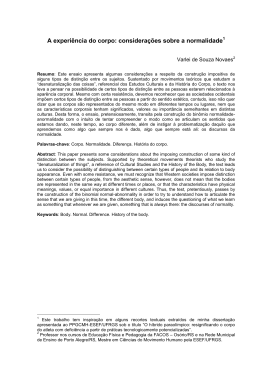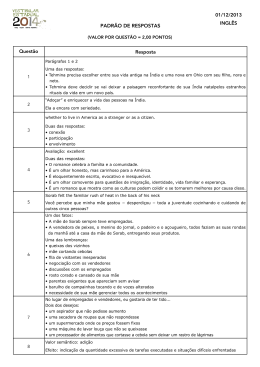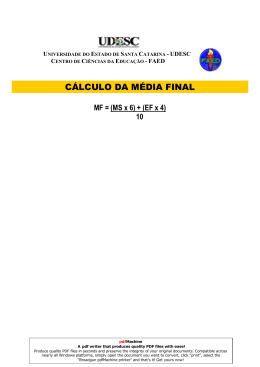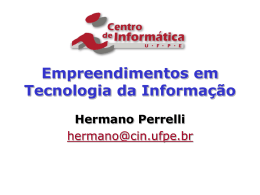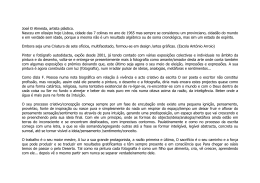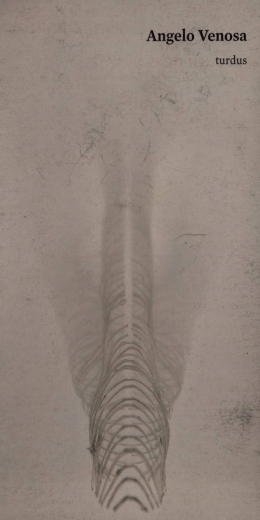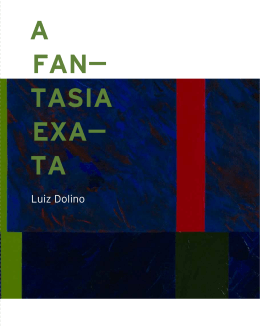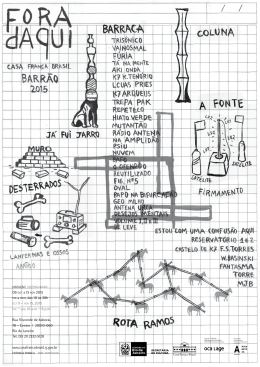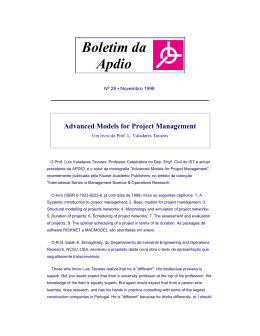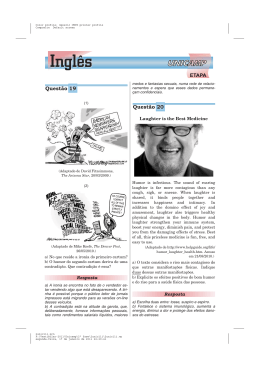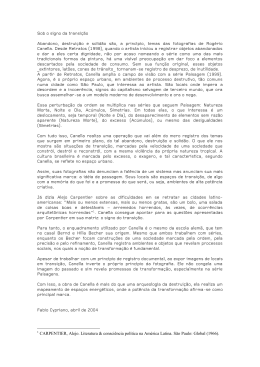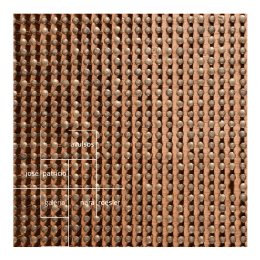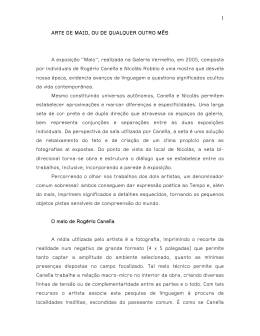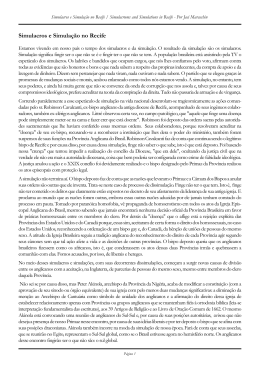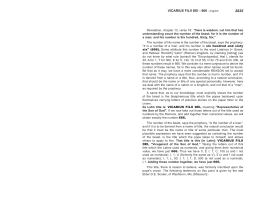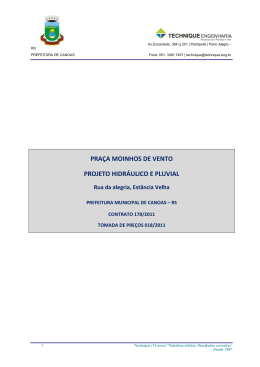VERMELHO NICOLÁS ROBBIO A FORÇA É LIMITADA PELA NECESSIDADE CONTATO / CONTACT END / ADDRESS TEL / PHONE WEB [email protected] RUA MINAS GERAIS . 350 . CEP:01224-010 . HIGIENÓPOLIS . SÃO PAULO . BRASIL 55 11 3138-1520 WWW.GALERIAVERMELHO.COM.BR / [email protected] RELEASE Expondo regularmente na Vermelho desde 2005, Nicolás volta a ocupar as salas da galeria com três novas instalações, sendo que uma delas faz referência direta à seta apresentada em “Maio”, sua primeira individual na galeria, há sete anos. O universo simbólico criado por Robbio em “Maio”, já apontava para o que, atualmente, constitui seu vocabulário de imagens, composto por diagramas, desenhos técnicos e elementos arquitetônicos. Isolados, justapostos ou recombinados esses elementos têm o objetivo de sugerir diferentes formas de percepção e leitura de sistemas representacionais altamente difundidos no mundo atual. O maior trabalho daquela mostra foi uma pintura, uma grande seta negra, que escapava do espaço físico destinado à sua exposição, e que invadia a sala inferior, ocupado na época pela individual de Rogerio Canella, sugerindo com a obra dois polos opostos: um deles repleto de luz, representado pela superfície branca das paredes onde Canella instalou suas fotografias, e outro desprovido de luz e de objetos representado nas paredes pretas. Ideia semelhante surge na obra “Pelo princípio de erguer”. Nela, Robbio divide o cubo branco da Vermelho em duas partes, por meio de uma estrutura de madeira, e cria, literalmente, um novo espaço: a parte inferior, acessível pelo piso térreo da galeria, é totalmente desprovida de luz; a superior, essa sim iluminada e não acessível, é ocupada apenas pela escultura de um lobo. A partir da experiência da gravidade, Robbio cria um universo que vai além da física, ou seja, muito além daquilo que mantem o homem em pé. Para o artista, a força que nos mantem aterrados sobre a terra é a mesma que nos eleva - seu campo de ação está localizado no espaço intermediário entre esses dois extremos. A materialização dessas ideias aparece também na instalação “A 90°”, que ocupa a sala 2 da Vermelho. Nela, o artista continua a abordar a questão da gravidade, a partir de dois extremos que na verdade parecem negar esse conceito. Instalada sobre uma das paredes da sala, a obra cria um mapa composto por linhas retas que, sob o efeito de pesos posicionados nos extremos de uma imbricada engrenagem feita com cordas, parece sustentar a cosmologia, ou melhor, o imaginário do artista. Completa a individual a instalação “1+2+3+4” onde mais uma vez Robbio busca questionar as leis da física. Feita em madeira, a obra foi posicionada em um canto do hall de entrada da Vermelho e tem como objetivo anular o imperativo da arquitetura que exige que para que algo permaneça em pé, um outro elemento funcione como estrutura. Os questionamentos propostos na individual parecem bastante oportunos no mundo atual. Eles sugerem a superação de modelos anteriores de relação entre cultura e sociedade, baseados na aceitação de ideias opostas e frequentemente antagônicas. Usando referências da arquitetura, da estética, da física, da história e da literatura, Robbio defende a tese de um mundo cheio de nuances, decorrência do confronto entre racional e subjetivo, entre presente e passado, entre apropriado e original, entre individuo e coletivo. RELEASE Having exhibited regularly at Vermelho since 2005, Nicolás Robbio is returning to occupy the gallery’s rooms with three new installations, one of them being a direct reference to the arrow presented in Maio, his first solo show at the gallery, seven years ago. The symbolic world created by Robbio in Maio already foreshadowed his current vocabulary of images made up of diagrams, technical drawings and architectural elements. Isolated, juxtaposed or recombined, these elements suggest different forms of the perception and reading of representational systems, rife in the world today. The largest work at that show was a painting of a large black arrow, which escaped from the physical space allotted to the exhibition and invaded the space of the lower room, at that time occupied by a solo show by Rogerio Canella, thus suggesting two opposite poles: one of them full of light, represented by the white surface of the walls where Canella installed his photographs, and the other bereft of light and of objects, represented on the black walls. A similar idea emerges in the work “Pelo princípio de erguer” (By the principle of standing up). In it, Robbio uses a wooden structure to divide the white cube of Vermelho into two parts, literally creating a new space: the lower part, accessible through the gallery’s ground floor, is totally without light; the upper one is illuminated but not accessible, and is occupied only by the sculpture of a wolf. Through the experience of gravity, Robbio creates a universe that goes beyond the physical one, that is, far beyond that which keeps man standing upright on the earth. For the artist, the force that keeps man on the ground is the same one that elevates him: his field of action is located in the intermediary space between these two extremes. The materialization of these ideas also appears in the installation “A 90°” (At 90 degrees), which occupies Vermelho’s Room 2. In it, the artist continues to deal with the question of gravity, based on two extremes that seem to negate gravity. Installed on one of the walls of the room, the installation creates a map composed of straight lines, which under the effect of weights positioned at the ends of a complex network of ropes sustains the artist’s cosmology, or better put, his imaginary realm. In the installation, Robbio alters the established visual patterns, suggesting a revision of the intimacy we have with the logic of these already deciphered and catalogued systems, pointing to the impossibility of any total comprehension of their complexity. The solo show is capped off with the installation “1+2+3+4”, where once again Robbio seeks to question the laws of physics. Made of wood, the artwork was positioned in a corner of Vermelho’s entrance hall and aims to annul the architectural imperative that for something to remain upright another element should function as a structure. The questionings proposed at this solo show seem very timely in the current world, which suggests the surpassing of previous models of the relation between culture and society, based on the acceptance of opposite and often conflicting ideas. Using references from architecture, aesthetics, history, psychology and physics, Robbio espouses the thesis of a world full of nuances, arising from the confrontation between the rational and the subjective, between present and past, between appropriated and original, between individual and collective. TÍTULO / TITLE ANO / YEAR DIMENSÕES / DIMENSIONS TÉCNICA / TECHNIQUE SEM TÍTULO 2012 21X 32,5 CM (DÍPTICO) ESCULTURAS DE MADEIRA UNTITLED 2012 21X 32,5 CM (DIPTYCH) WOODEN SCULPTURES TÍTULO ANO DIMENSÃO TÉCNICA TITLE YEAR DIMENSION TECHNIQUE 1+2+3+4 2012 VARIÁVEL ESCULTURA DE MADEIRA EM PAREDE BRANCA 1+2+3+4 2012 VARIABLE WOODEN SCULPTURE IN WHITE WALL TÍTULO / TITLE ANO / YEAR DIMENSÕES / DIMENSIONS TÉCNICA / TECHNIQUE PELO PRINCÍPIO DE ERGUER 2012 VARIÁVEL ESTRUTURA DE MDF E COMPENSADO PELO PRINCÍPIO DE ERGUER 2012 VARIABLE MDF STRUCTURE AND PLYWOOD DETALHE / DETAIL DETALHE / DETAIL TÍTULO / TITLE ANO / YEAR DIMENSÕES / DIMENSIONS TÉCNICA / TECHNIQUE A 90° 2012 VARIÁVEL CORDA, METAL, MADEIRA, GALHOS, PLÁSTICOS, CERÂMICA, PAPELÃO, OSSO, PEDRA E PAPEL A 90° 2012 VARIABLE ROPE, METAL, WOOD, TWIGS, PLASTICS, CERAMICS, CARDBOARD, BONE, STONE AND PAPER DETALHE / DETAIL TÍTULO / TITLE ANO / YEAR DIMENSÕES / DIMENSIONS TÉCNICA / TECHNIQUE SEM TÍTULO 2012 235 x 100 x 90 CM MDF E MOEDAS UNTITLED 2012 235 x 100 x 90 CM MDF AND COINS
Download
